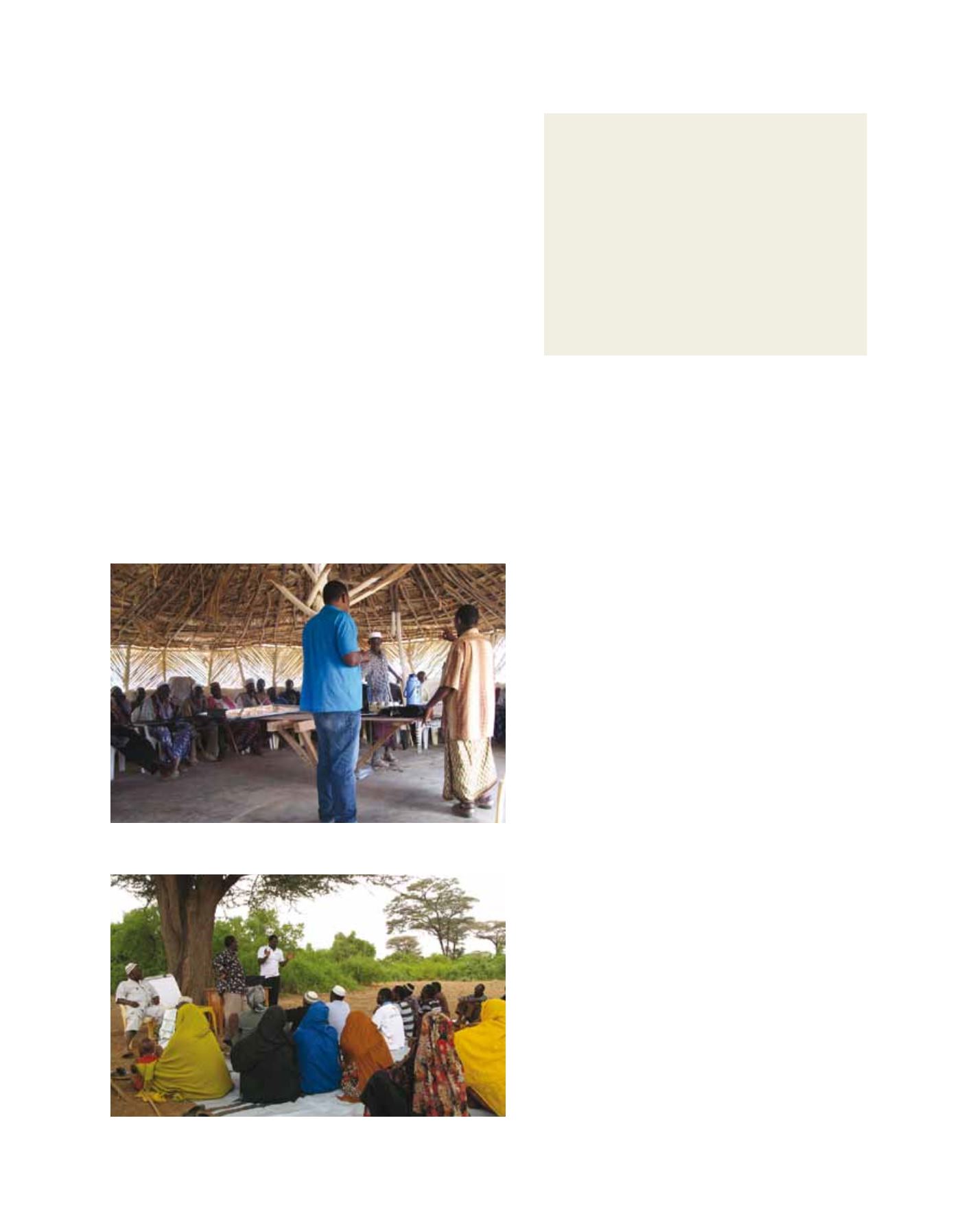

A
griculture
(KMD) have agreed as the most appropriate or feasible for adapting
to the upcoming seasonal climate/rainfall patterns derived from the
seasonal forecast. The information is disseminated in meetings that
bring together the team of experts and the farmers. In all the locations,
farmers showed keen interest in receiving and using the advisory on a
regular basis. The experts also undertake field visits during the rainfall
season to assess the performance of crops and provide any additional
advice to the farmers.
During the pilot period, farmers were able to tailor crop
management to expected seasonal climate conditions. Farm level
investments could be restricted during predicted bad years, and
expanded when good rainfall – and thus good returns to crop
investments – is forecast. In practice, it was observed that a broad
indication (season likely to be good, average, poor) is sufficient for
making good decisions, especially in smallholder agriculture.
A survey conducted to evaluate the usefulness of the advisories
showed that most farmers considered the advisories as extremely
useful in planning their farm operations, an observation well
supported by a willingness of 87 per cent of the farmers interviewed
to pay for the service if required.
The pilot research with weather-based agro-advisories has estab-
lished that farmers can derive significant benefits from the use of
climate information, if it is interpreted for location-specific needs and
presented in a format they can easily understand. The challenge is to
develop location-specific advisories quickly, efficiently
and cost-effectively; and deploy them in time without
any delay so farmers and their support agents can make
the best use of them to mitigate or take advantage of vari-
able climate ahead of the season.
Mainstreaming climate information – Isiolo County
The Ministry of State for Development of Northern
Kenya and other Arid Lands and the Ministry of State
for Planning, National Development and Vision 2030,
with support from the International Institute for
Environment and Development (IIED) and other part-
ners in Kenya, designed approaches that strengthen
institutional capacity for climate adaptation in Kenya’s
arid lands that can be taken to a larger scale in a subse-
quent phase. These approaches are being tested through
an action research project in Isiolo County, which will
maximize opportunities for the pastoral community.
IIED is a policy research institute based in the UK. It
is globally recognized for both its work on dry lands and
climate change research, capacity-building and policy
advocacy, and its participatory approaches.
KMD was brought on board in the project after
the first workshop in May 2010 where, the pastoral
communities in Isiolo identified climate change as the
main problem affecting their activities.
It emerged that when all these activities are planned
well in advance, the impacts of droughts on the commu-
nity are minimized compared to when they are caught
unawares. It became important that KMD should be
incorporated in the project to directly provide climate
forecasts to these pastoralists and support other govern-
ment departments to plan well. The project is still in
its formulation stage, but as its implementers meet the
community, one member of KMD personnel is always
there to sensitize them to the benefits of climate infor-
mation and seasonal weather forecast and advise on
expected rainfall patterns and potential impacts. Three
such sessions have so far been held.
Weather briefing sessions
In July 2011, the first advisory was delivered to pasto-
ralists based on the June-July-August 2011 seasonal
Isiolo County: community activities in response to
drought
•
Scouting by groups to collect information
•
Preparation of pasture areas and rehabilitation of
shallow wells
•
Security surveillance
•
Preparations of machines (water pumps, generators)
•
Estimation of pasture quantity and quality
•
Planning for water management
•
Negotiations with elders in other communities for pasture
•
Resource mobilization – financial
•
Intensive planning for migration (beasts of burden,
stopovers, women and children, mapping the route)
•
Migration to pasture areas within and outside the county
(Laikipia, Samburu, Meru, Wajir, Marsabit, Garissa,
Mandera).
The March-April-May 2012 forecast briefing in Gafarsa, Garbatula
The March-April-May 2012 forecast briefing at Merti
Image: KMD
Image: KMD
[
] 26
















